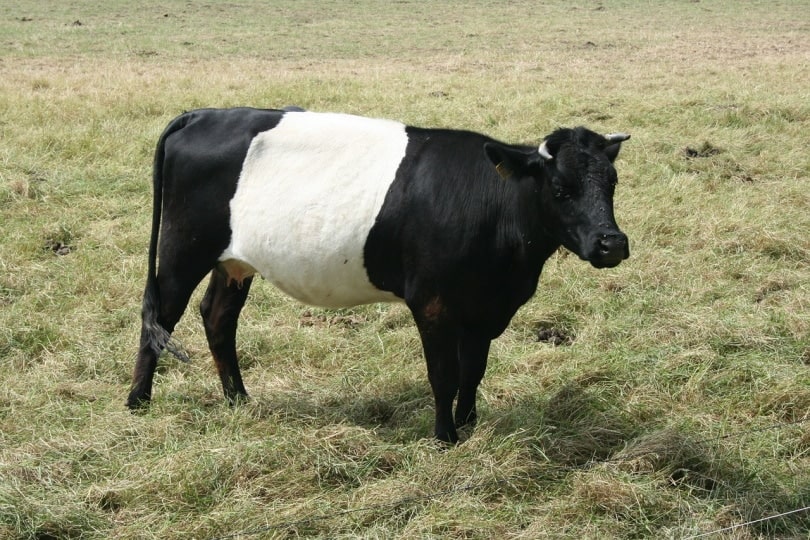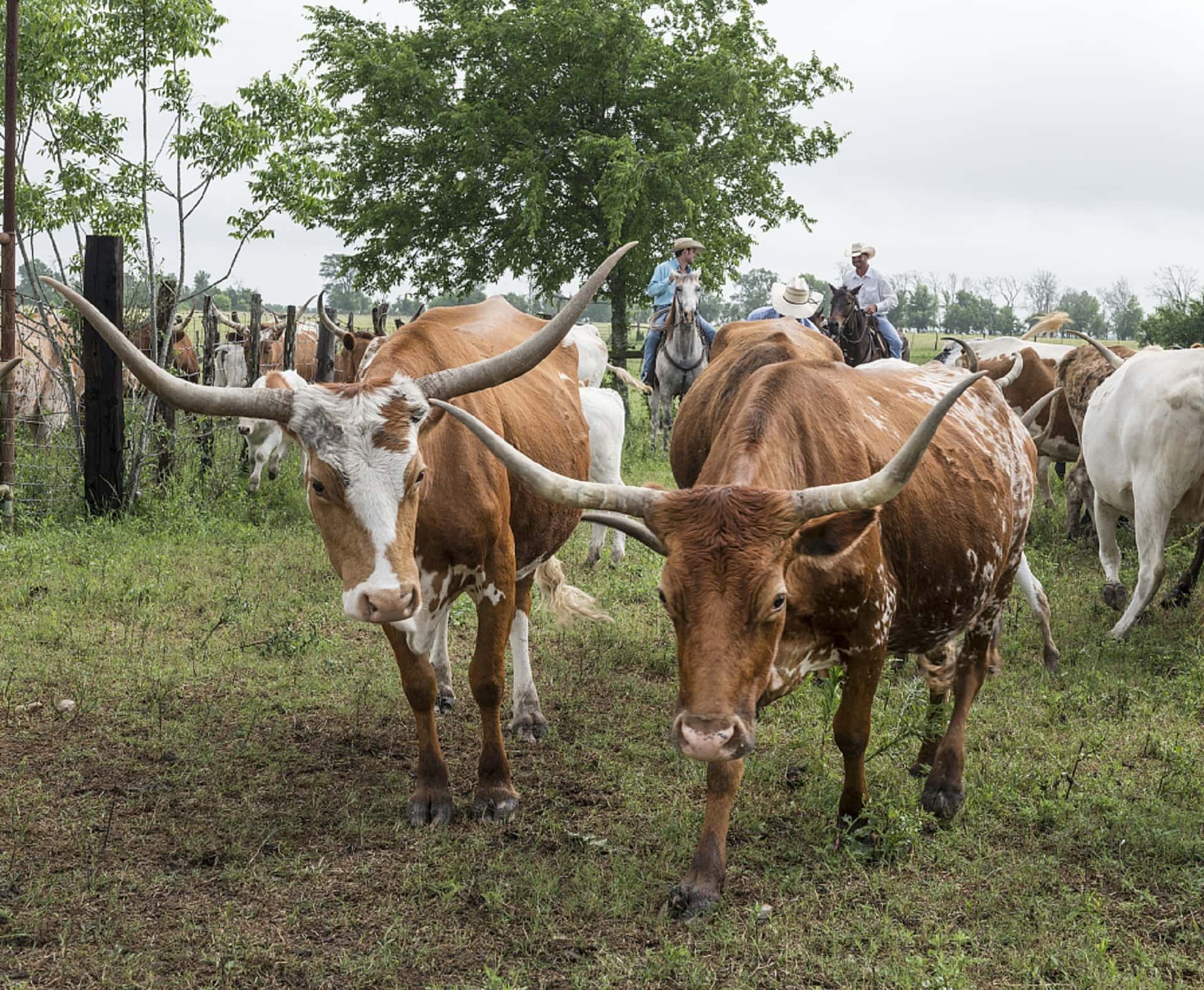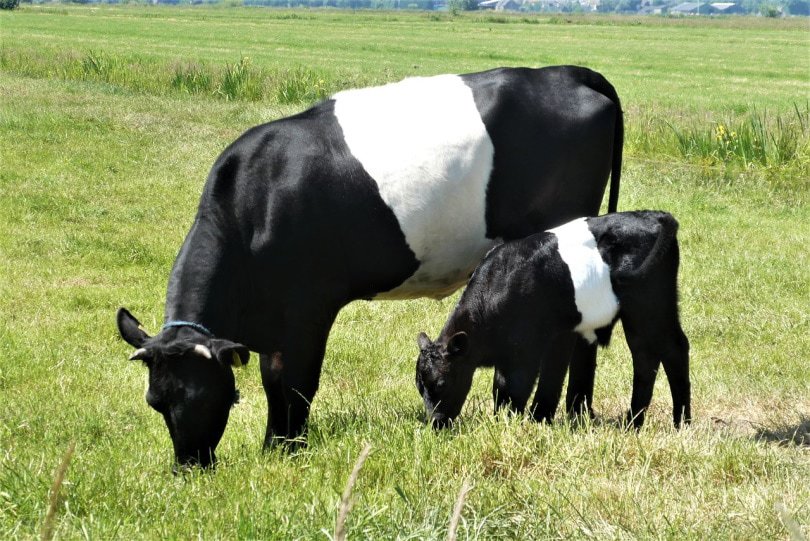Despite the many romanticized images of black and white cows roaming the countryside, this color combination is extremely rare in cattle. The most well-known is the Holstein, a dairy cow that can be found worldwide. But did you know that there are actually 15 breeds of black and white cattle?

The 15 Most Common Black and White Cow Breeds
1. Holstein Friesian Cattle
Holsteins are easy to recognize. These dairy cows have black and white spotting, but they can also have markings of black and red. This breed has an outstanding level of milk production, making it the most commonly used cow on dairy farms.
Holsteins were originally bred to produce large amounts of milk on small amounts of feed. The breed’s roots come from breeding black Batavian cattle with white Friesians. The first Holstein came to the United States in 1852 and has remained the #1 dairy cow breed ever since.
The average production lifespan (the number of years that they produce milk) of a Holstein is 6 years. They are milked three times a day, on average, to produce 72,000 pounds of milk per year.
2. Lakenvelder

Lakenvelder cattle, also called Dutch Belted cattle, are striped cattle named for their belted appearance. This breed is native to Switzerland and Austria but migrated to the Netherlands in the 17th century.
The distinguishing feature of Lakenvelder cattle is the white belt around their middle. They were originally raised as dairy cows but are more productive as beef cattle due to their stocky frame.
3. Brahman Cattle
Brahman cattle are considered sacred in India and are recognizable by a large hump on their back. This breed has an extreme tolerance to harsh weather conditions because they have survived for decades with inadequate food supplies.
In North America, Brahman bulls (male cows) are famously raised as rodeo stock. In Houston, Texas, the American Brahman Breeders Association verifies and tracks bloodlines to ensure that the breed remains pure.
4. Belted Galloway

“Belties” or “Oreo Cattle” have a distinctive white belt, similar to that of the Lakenvelder. This breed is known for their ability to survive the harshest of winter conditions, as their hair is double-coated.
The Belted Galloway is a medium-sized, hardy breed that’s bred primarily for beef.
5. Guzerat
The Guzerat is known by many different names, including Guzera, Gujera, Gujrati, Gusera, and Guzerath. They have distinct black markings on their head and forequarters. These powerful cattle are used primarily as draft animals. They have long horns and a similar build to the American Brahman. They are also bred for beef and dairy production.
While the Guzerat breed currently resides in India, they originated in Brazil as a result of crossing Indian Kankrej cattle with Taurine Crioulo cattle. They were dubbed the Guzerat, a Portuguese name, to honor their ancestors.
6. Texas Longhorn

Texas Longhorn cattle are easily recognized by their color patterns and long horns. These cows have a gentle disposition, are highly intelligent, and hold great economic potential in the cattle industry.
This breed comes in many different colors, including white with black markings. While their horns are their most distinguishing feature, they are also known for their high fertility rates and ease of calving. Texas Longhorns have become more popular in the beef industry in recent years due to their high-quality, lean beef.
7. Dhanni
Hailing from the Punjab region of Pakistan, Dhanni cattle have distinct splashing on their belly and legs, giving them an appealing black and white color pattern.
Dhannis can be dated back to Alexander the Great, who brought black cattle with him on his many adventures. After arriving in Pakistan, they bred with local white cows, resulting in what is currently the Dhanni.
Pakistani farmers use this breed for dairy, meat, and draft work, and they are also popular for use in steer riding and cattle showing. In more rural areas, you can still see these cows hooked up to plows and being used for manual farm labor.
8. German Black Pied
Smaller and more fertile than the Holstein, the German Black Pied is a three-breed cross. The breed began in 1963, starting with crossing a Jersey bull with a German Black Pied cow. The descendants of this cross were then bred to a Holstein to develop the current German Black Pied breed.
While they have a strong resemblance to Holstein cattle, the German Black Pied has a longer lifespan. They also retain the incredible milk production characteristics of their ancestors.
9. Blaarkop
The black and white Blaarkop is a Dutch cattle breed. Blaarkop is a Dutch word that translates to “Blister Head.” The name refers to patches of color, or blisters, that these cattle get around their eyes and face. These cows are mostly black with a white head and belly, making them easy to spot.
The Blaarkop has a long history, dating as far back as the 14th century. The lineage of this breed can be traced back to livestock in the Middle Ages, and this breed is still bred in the province of Groningen, Netherlands. It’s a dual-purpose breed used for both dairy and meat production.
10. Girolando

The Brazilian Girolando is an extremely adaptable breed of cattle that’s resistant to tropical diseases and hot climates. As superior foragers, they are easy to keep and require no assistance to find food.
The Girolando breed was derived from a Holstein and a Gyr in an effort to increase dairy production in Brazil. They’re often confused for Holsteins due to their physical resemblance, but they are considered distinct. Girolando cattle are responsible for approximately 80% of the milk production in Brazil.
11. Cholistani
A Pakistani cattle breed, the Cholistani has a solid white coat with black color spotting. These cattle are honored as an ornamental breed and can often be seen with flowers and headwear.
The origins of the Cholistani aren’t clear, but locals believe that the breed hails from the Cholistan desert. They are used primarily for farm work but also provide milk and beef.
12. Umblachery
The Umblachery is honored in India for their strong build, work ethic, and distinctive color patterning. They bear a close resemblance to Kangayam cattle, with short thick horns, a well-developed hump, and strong legs.
These cattle are primarily bred for agricultural fieldwork, specifically farming rice paddies, but they also provide a decent amount of milk.
13. Yaroslavl Cattle
Russian Yaroslavl cattle have a white head with black rings around their eyes. They are dairy cows, counted among the best dairy breeds in the world. Not much is known about the breed’s origins, but they can be dated back to the 19th century.
14. Lineback
American Lineback cattle have distinctive black and white markings and a gentle disposition. The name comes from the white line that runs down the back of this black cow.
They are descended from Friesians, Ayrshires, Herefords, Milking Shorthorns, and Longhorns, giving them an interesting genetic mix. The American Lineback Cattle Association was developed in 1985 to begin tracking the bloodlines of Lineback cattle and continues to do so today.
The Lineback is a dual-purpose breed, meeting the demands of milk and beef production.
15. Kherigarh
An Indian cattle breed, the Kherigarh has an oversized hump and loose skin. They are also a working breed with a strong work ethic. Depending on the region of India that you’re in, they are also called Kheri, Chandigarh, and Khari.
They are used for both draft work and milk production, being reported to yield approximately 500 kg of milk per year.

Final Thoughts
Black and white cattle breeds stand out for their unique markings and color patterns. There are many different black and white breeds that fulfill many purposes around the world. Many black and white cattle are bred specifically to maintain their color patterns due to a strong preference for their markings over other common coat colors.
Related Reads:
- 10 Rarest Cattle Breeds in the World (With Pictures)
- 10 Most Popular Cattle Breeds in the US (With Pictures)
Featured Image Credit: Elsemargriet, Pixabay
